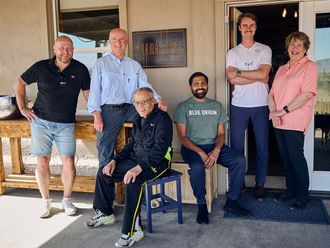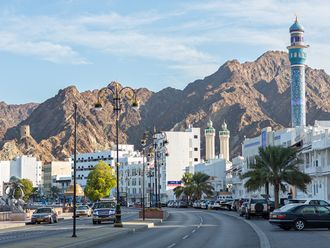Cambridge Massachusetts: That genial face has become familiar across the globe almost as recognisable when it comes to religious leaders, perhaps, as Pope John Paul II.
When in America, the Dalai Lama is a sought-after speaker, sharing his compassionate message and engaging aura well beyond the Buddhist community.
After inaugurating a new Dalai Lama Centre for Peace and Education in Vancouver, British Columbia, the Tibetan leader has begun a visit to several US cities for public talks, sessions with young peacemakers, scientists, university faculty, corporate executives, and a California women's conference. But he'll also sit down for teach-ins among the burgeoning American faithful.
Buddhism is growing apace in the United States, and an identifiably American Buddhism is emerging. Teaching centres and sanghas (communities of people who practice together) are spreading here as American-born leaders reframe ancient principles in contemporary Western terms.
Though the religion born in India has been in the United States since the 19th century, the number of adherents rose by 170 per cent between 1990 and 2000, according to the American Religious Identity Survey. An ARIS estimate puts the total in 2004 at 1.5 million, while others have estimated twice that. "The 1.5 million is a low reasonable number," says Richard Seager, author of Buddhism in America.
That makes Buddhism the country's fourth-largest religion, after Christianity, Judaism, and Islam. Immigrants from Asia probably account for two-thirds of the total, and converts about one-third, says Dr Seager, a professor of religious studies at Hamilton College, in Clinton, New York.
What is drawing people (after that fascination with Zen Buddhism in the '50s and '60s)? The Dalai Lama himself has played a role, some say, and Buddhism's nonmissionising approach fits well with Americans' search for meaningful spiritual paths.
"People feel that Buddhist figures like the Dalai Lama and Thich Nhat Hanh of Vietnam are contributing something, not trying to convert people," says Lama Surya Das, a highly trained American lama in the Tibetan tradition.
"They are not building big temples, but offering wisdom and ways of reconciliation and peacemaking, which are so much needed."
"People are looking for experiential practices, not just a new belief system or a new set of ethical rules which we already have, and are much the same in all religions," Surya Das says. "It's the transformative practices like meditation which people are really attracted to."
At a sangha sitting in Cambridge last week, some 20 devotees sat cross-legged on four rows of large burgundy-coloured cushions before a small candlelit altar. A practice leader led a quiet hour of meditation interspersed with the chanting of prayers and mantras. The group then gathered in a circle for a half hour of discussion.
Carol Marsh, an architect who served as practice leader for the evening, had an interest in finding a spiritual path for years, but was "resistant to anything nonrationalist", she says later in an interview. "Then I read Awakening the Buddha Within, [Surya Das's first book on "Tibetan wisdom for the Western world"], and it spoke to me directly ... My ultimate aim is liberation."
After eight years of practicing, "I am happier, more grateful, more able to roll with whatever punches or moments of annoyance may present themselves".
What's so valuable to Jane Moss, who's been practicing 15 years, is learning how "to be in the present moment". And also to accept that reality involves perfection and "to view the world as good and people as basically loving".
Each month, the group holds a meditation focused on love and compassion.
The sangha has been meeting since 1991, when Surya Das opened the Dzogchen Centre here after decades of training with Tibetan teachers. Before becoming a lama, he was Jeffrey Miller, raised in a middle-class Jewish family in Brooklyn. An anti-Vietnam-War activist while at the University of Buffalo, New York, he was stunned when his good friend Allison Krause was shot and killed by the National Guard at Kent State in 1970.
"When I graduated in 1972, I was disillusioned with radical politics I realised fighting for peace was a contradiction in terms, and I wanted to find inner peace," he explains. Instead of graduate school, the young Miller headed off on a search that ended up in the Himalayas, where he spent the rest of the '70s and '80s learning from Buddhist teachers while teaching some of them English.
"One of the great lessons of that monastic brotherhood was learning to love even those people I didn't like," he says over the phone from a retreat in Texas where he's training others.
There are many schools of Buddhism, but "everyone agrees that the purpose is the individual and collective realisation of Enlightenment", Surya Das continues. "That is defined as nirvanic peace, wisdom, and selfless love. It involves a practice path that depends on meditation, ethical behaviour, and developing insight and active love."
Buddha means "awakened" in Sanskrit, a language of ancient India, where Siddhartha Gautama founded the faith and an Eightfold Path some 2,500 years ago. Buddhists believe that through that path one awakens to what already is "the natural great perfection". They do not speak of God, but of the human or ego mind with a small "m", and the Buddha (awakened) Mind with a big "m".
"Healing energy takes place through an agency far greater than, yet immanent in each of us," Surya Das has written. "We are all Buddhas."
One doesn't have to subscribe to a catechism or creed, or be a vegetarian. Nor do people have to give up their religion.
The Dalai Lama, in fact, often encourages people to stay with the faith of their cultural upbringing, to avoid the confusion that can sometimes result from a mixing of Eastern and Western perspectives.













